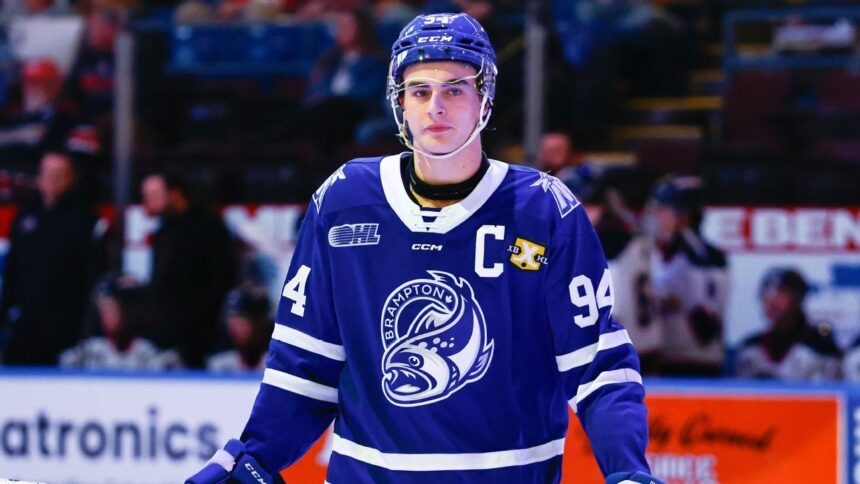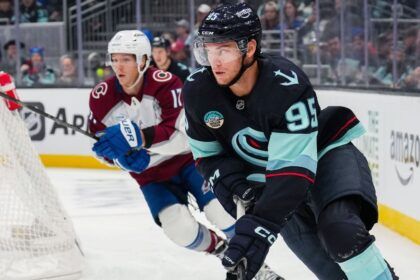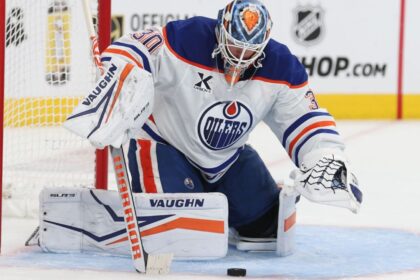NHL Draft Week: Analysis of the Top 64 Prospects
The NHL draft week has arrived, and with it, the final rankings of the most promising prospects. This comprehensive analysis examines the top 64 players, detailing their skills, areas of development, the perception of NHL scouts, and their projections for the league. After Matthew Schaefer and Michael Misa, the consensus decreases considerably. Valuations vary between teams, influenced by organizational priorities and the characteristics sought in players. This could lead to strategic moves during the draft.Here are the top 64 prospects, along with honorable mentions:A player’s success is not defined by their draft position, but by their development over the years.
Alofoke Deportes Analysis
1. Matthew Schaefer, D, Erie (OHL)
It is projected as a central defender who will be fundamental in the future. With great mobility and skill at both ends of the court, this 6’2″ defender stands out for his ability to stop opponents and generate offensive opportunities. Executives and scouts see him as an elite NHL defenseman and a key piece for a team with championship aspirations. His ability to control the game from the blue line, play against tough rivals and lead the power play, along with his character and leadership, suggest that he has the potential to become a top-10 defenseman in the league, even wearing a captain’s letter.2. Michael Misa, F, Saginaw (OHL)
With exceptional status in the OHL since 2022, Misa had a remarkable goal-scoring season in 2024-25, with 62 goals in 65 games. He is shaping up to be a top-line forward capable of surpassing 90 points per season in the NHL. His offensive instincts are elite, processing the game at high speed. Scouts believe he is ready for the NHL and has the potential to become an elite first-line center. Off the puck, Misa excels at finding space in coverage and his ability to perform in crucial moments. His combination of playmaking and goal-scoring ability makes him a constant threat in the offensive zone. His two-way game has improved noticeably, with increased defensive awareness and commitment to a 200-foot game. Along with his explosive speed and offensive power, Misa is a fundamental player.3. James Hagens, F, Boston College (NCAA)
It is projected as a first-line center or one of the best second-line centers in the NHL. Although he doesn’t have Misa’s dynamism, he opts for a cerebral and efficient style of play. He brings a good work rate with excellent speed and passing ability, which should allow him to direct the game effectively in the NHL. Scouts and executives are impressed with the professional details of his game (puck support, winning battles, defensive play with the puck), and believe that it will facilitate the transition to the NHL while he finds his offensive rhythm. Playing another season at Boston College to further develop his dynamic offensive game, which impressed scouts during his season at the NTDP (with 102 points), could be the solution. After playing on one of the best college hockey lines with Gabe Perreault and Ryan Leonard, Hagens would now rely on leading his own line, creating offense through his own play, and playing a significant role in matchups. Hagens has the potential to be the complete package in the NHL. His understanding of space and his ability to anticipate stand out among his peers. He is smaller and thinner than other prospects, which worries some teams, but he has a mix of Clayton Keller and Jack Hughes in terms of transition play and creativity.4. Porter Martone, F, Brampton (OHL)
A big, intelligent forward, Martone is a dual-threat offensive player with the ability to score and facilitate play. He projects as a second-line scoring winger who should get power-play minutes. His competitive nature will make him an effective agitator as he learns to physically impose himself on his opponents. He needs to refine competitiveness and physicality to increase his effectiveness, but he is exactly the type of player that teams covet due to the unique combination of offensive talent and competitive spirit. Martone’s ability to score and make plays will make him a difficult player to defend in the NHL. There are concerns about Martone’s speed and skating posture. His speed has improved this season, but Martone needs to add explosiveness to his skating to reach his potential.His unique combination of scoring ability, size, and durability make him a very attractive prospect. While his safest projection is as a top-six forward, Martone has a legitimate chance to become a top-line winger if he improves his skating.
5. Anton Frondell, F, Djurgardens (Allsvenskan)
Frondell is a versatile two-way forward who plays both center and right wing. His flexibility is attractive to teams, although many believe he is more likely to reach his potential as a winger in the NHL. Frondell comes from one of the most productive seasons of a player under 18 in the history of Allsvenskan, giving him a secure projection as a top-line NHL forward. He is a cerebral player, who analyzes defenders in individual situations and defensive coverage in the offensive zone game. Frondell’s game details are translatable, including an excellent forechecking ability, the willingness to attack the center of the ice, and high-level anticipation on both sides of the puck.He has demonstrated game-driving capabilities against men in the Allsvenskan, which has translated to the NHL for other prospects in the past. He is projected to produce between 75 and 85 points per season. His playing style translates well and executives are excited about his ability to enter the league in the next 18 months.
He impressed during the physical tests and interviews at the scouting combine, leaving many teams impressed. His two-way ability combined with great anticipation and a high-level shot make him one of the most exciting prospects in the class.6. Roger McQueen, F, Brandon (WHL)
Described as “a unicorn” because he is a 6-5 center who skates with the speed and mobility expected of a smaller player, McQueen has been a hot topic all season. He profiles as a modern, prototypical power forward who combines soft skill with physicality. Right-handed elite centers are rare in the NHL, and McQueen’s size and willingness to dictate play physically add undeniable value. He has professional defensive habits that are translatable to the NHL, and unique offensive upside that is still developing given lost playing time due to an injury during his draft season. McQueen dominates the cycle game, creates offense on the rush, and uses his physical gifts to dominate the cycle and protect the pucks. His projection as an elite top-line center lacks confidence, due to the lack of playing time because of his back injury. Without the injury, we could be discussing McQueen near the top of this draft class because his skating package, skill, and physical gifts are rare, and the type of toolbox that executives dream of. It’s a textbook case of a high-risk, high-reward player; however, his performance at the scouting combine demonstrated that his back injury had completely healed. Playing against tougher competition, where McQueen will be forced to develop his ability to protect himself, puck control, and the ability to create offense against larger bodies will be important. If he develops without setbacks, he could become a two-way force in the NHL in the coming years.7. Caleb Desnoyers, F, Moncton (QMJHL)
Desnoyers could ascend much higher than where I have him, because he could be one of the best two-way players in the draft. Described as “a coach’s dream” due to his ability to take on an offensive or checking assignment and execute it consistently. He makes smart and simple plays, provides a physical presence on the forecheck, and generally agitates and makes life difficult for defensemen. It is projected as a quality second-line center with a good chance of becoming a first-line player. He is cerebral, with quick hands and playmaking ability. He is not flashy, but he is consistently effective and makes smart plays with the puck. Executives love to hear the word “reliable” from scouts, and that word is perfect to describe Desnoyers. He gives his best in high-pressure games because he finds a way to make the plays needed to win. Many scouts believe he will be a leader in the NHL, with a solid game on both sides of the puck, in all situations. As an exploration director described, “he’s the kind of player you win with.” Some have quietly compared him to Patrice Bergeron and Jonathan Toews, which are lofty comparisons, to say the least.8. Jackson Smith, D, Tri-City (WHL)
Smith is a big, physical defenseman with untapped offensive ability and is the consensus second-best defenseman in the draft class behind Schaefer. Possesses all the qualities of a top-four matchup type. Defends the run well, closes spaces, and directs the game in transition, making him one of the best neutral zone transition defenders in the class. Given the importance of transition defense in a matchup role, Smith has a real opportunity to be the player coaches rely on to play many minutes against top players. His combination of skating, size, and poise with an offensive game that progressed positively as the season went on makes me believe there’s more to give, and playing at Penn State next season should help. Smith is 6-3, and executives love the simplicity of his game, reading the pressure, disrupting plays, and making effective passes to get out of the zone. He lacks explosive skating and the constant creativity needed to be a quality offensive contributor at the NHL level, but his reads are there to be a positive transition player and join the rush as a support player. Smith’s development from here will consist of using his excellent mobility to avoid the running offense and become a more consistent offensive threat with better puck management. If Smith can direct the game on both sides of the puck in transition and become a threat on the power play, there is a real possibility that he will become a number 2 defenseman at the NHL level.9. Jake O’Brien, D, Brantford (OHL)
Deceptive and incredibly smooth, O’Brien projects as a top-six center who produces points with the potential to become a top-line center. The right-shot pivot is one of the best playmakers in the draft, creating high-danger opportunities regularly; for me, he’s the best pure playmaker in the draft. He constantly manipulates defenders, distributes the puck with his forehand and backhand, and uses fakes that make defenders and goalies squirm. Development will come from simplifying offensive plays to eliminate turnovers caused by holding the puck for too long. O’Brien’s shot is going to be a necessary area of development if his pass wants to be an elite threat in the NHL. There is a risk here, because he is thinner than other players available in the center position, but he has room to fill in the coming years. O’Brien’s elite playmaking skills will be even more valuable if he can add a speed gear and increase his shot threat. He is two or three years away from playing an important role in the NHL, and patience could be the key for O’Brien to reach his top-line ceiling. If he does, he’s going to be an elite power-play quarterback and an offensive engine.10. Victor Eklund, F, Djurgardens (Allsvenskan)
Eklund projects as a top-six forward with a good chance to become a top-line contributor. There is a clear possibility he falls outside the top 10 this week, which would mean extreme value for anyone who selects him. Despite concerns about his size (he measures 5-11, 161 pounds), Eklund’s playing style is very translatable to the NHL. He plays much bigger than his measurements suggest, and there is room to add strength. If he grows, which has happened with other prospects in the past, Eklund’s projection becomes more secure as a 70-point producer with a high-level motor and excellent forechecking ability. Eklund is excellent in transition and attacks defenders with speed and fearlessness, driving inside and positioning his body to win or protect the puck. His smaller size has forced him to learn to protect the puck with excellent body positioning. If he develops a larger and stronger frame, those skills will make him even more difficult to defend in the offensive zone. His off-puck game is mature and will quickly earn the trust of NHL coaches. Eklund has the potential to be a difference-maker in a second-line role, and his combination of hard play with soft skill should translate more easily than other players.11. Carter Bear, F, Everett (WHL)
Bear is the type of player that a team looking for high-level instincts and playmaking craves. Before a season-ending injury in March, Bear was one of the CHL’s most dangerous offensive players and a reliable defensive forward. He is versatile, playing center and wing, and projects as a second-line 65-75 point player, most likely on the wing. It’s a quality playmaker who uses different passes to create advantages in dangerous areas. His ability to manipulate defenders and create space for his teammates while drawing coverage towards him should translate well to the NHL. He has good hands in tight spaces, making him a threat around the net, and is one of the best offensive facilitators in the draft class. In addition to his offensive gifts, Bear’s defensive game makes him a quality two-way player. His stick position allows him to disrupt passes, and he is a tenacious forechecker who tracks well on the backcheck and finishes checks. His skating posture needs to be more upright to allow him to develop a more explosive stride to take advantage of his offensive skills in transition, but the instincts and execution of plays already exist. Bear is a good combination of soft and hard skill with projectable traits on both sides of the puck, and is the type of player who should thrive in a matchup role while contributing offensively.12. Radim Mrtka, D, Seattle (WHL)
A 6-6 right-handed defenseman with decent mobility who plays in all situations has scouts very excited, and could be the second defenseman selected on Friday. He is very difficult to get past, routinely frustrating attackers in his path and killing plays. He projects as a top-four shutdown defenseman due to his excellent stick work, mobility, and transition defense. Mrtka uses his mobility to escape pressure, activate on the rush, and make quality passes to the center of the ice. Mrtka should become a strong transition defender, a reliable penalty killer, and an efficient puck mover. He shoots the puck with power and could become a more scoring threat if he can pick his spots to put the pucks in. While everything flowed through him in Seattle, there are well-founded concerns about his lack of offense. His size and physicality give him the tools to become a defenseman who consumes minutes and closes out the game if his mobility continues to progress. His late birthday gives him a lot of room for development to refine his skating, his offensive game, and his physicality in all areas of the ice.13. Brady Martin, F, Sault Ste. Marie (OHL)
A Swiss army knife type player who will be most effective on the wing due to his strong wall play, Martin projects as a six-and-a-half forward capable of routinely scoring 20 goals, with potential as a second-line forward. It’s a wrecking ball that will provide value in all three zones, with and without the puck. Martin has scouts excited after an excellent performance at the IIHF U18 championship, and many believe he could go very early in the first round. He’s a tireless worker without an off switch, bringing a combination of physicality and hard skill. He’s a nightmare to contain with his brute strength, and forces defenders into precarious positions with good speed and a willingness to make “winning” plays. Martin finds ways to get physically involved if he doesn’t have his “A” game offensively, and executives love that. If Martin’s scoring doesn’t translate, he’ll be a valuable third-line pest. Several teams mentioned how impressive Martin was during the combine interviews. He combines an attractive personality with a tough style, and forms a rare combination that is valuable to many scouts who believe he is the type of player teams need to win in the playoffs. Surely, his mention of Conn Smythe winner Sam Bennett as a role model caught attention. He is likely to go well before the teens, but that doesn’t devalue the players who will be selected after him.14. Justin Carbonneau, F, Blainville-Boisbriand (QMJHL)
Carbonneau possesses an offensive toolbox that teams covet, including powerful skating and amazing creativity. He projects as a second-line scoring forward with significant variance and is likely to end up as a middle-six player who thrives against secondary matchups. Carbonneau can drive offense with his playmaking and shooting ability, and plays a complete offensive game that includes playing through contact, excellent puck-handling skills, and above-average skating. As is the case with any player who possesses incredible potential, there is an inherent risk. He has a physically mature body (6-1, 191 pounds), and will need to adapt to the speed of the professional game. He thrives when given time and space, and his growth will come from learning to simplify his offensive game and make better decisions with the puck. There are tools to become a very effective power forward in the NHL who can score 25 goals if he adds a cerebral component to his game.15. Lynden Lakovic, F, Moose Jaw (WHL)
The left end of 6-4 has translatable annotation capability and excellent speed for its size. With room to fill out his frame, Lakovic is an attractive prospect. Attacks with linear crosses using his large frame to protect the puck, and makes plays using good deception. He has the potential to be a dual-threat winger at the NHL level if his passing translates the way many believe his shot will. Lakovic projects as a middle-six winger with a fair amount of confidence due to his scoring ability, speed, and size, but there is a chance he becomes a second-line scoring threat. Lakovic’s development will come from the physical side. While he is extremely skillful, he needs to lean on defenders and make his way to the center of the field to take advantage of his hands and quick shots. If he does this, he becomes a significantly more dangerous player, as he will be a threat in transition and off-cycle. That is certainly a developable skill that translates to any level, and combined with quality offensive instincts and skills, could make Lakovic a 65-point dual-threat winger.16. Logan Hensler, D, Wisconsin (NCAA)
The 6-2 defenseman projects to become a second-pairing defenseman who excels in transition. He is one of the best neutral zone defenders and puck movers in the draft, who steadily improved as a true freshman in the NCAA. His puck retrievals, breakout passes, and offensive zone passes consistently put his team in more advantageous attacking positions. Being a right-handed defenseman with excellent mobility and an easily translatable game makes Hensler a very attractive prospect in this class. There are concerns among NHL scouts regarding Hensler’s offensive skills and how he might perform in the NHL. However, Hensler showed flashes in the second half of the NCAA season, attracting defenders and making elegant plays for high-danger scoring opportunities. He is unlikely to become a 60-point defenseman, but 35-45 points as a consistent transition defenseman playing a shutdown role seems to be the appropriate projection. His NHL-ready structure is a plus, and will only improve throughout his college career, which will likely be another two seasons.17. Braeden Cootes, F, Seattle (WHL)
Cootes is likely to be the first center taken in the second half of the first round and will be a target for teams looking for a two-way, high-motor center. He lacks explosive offense, but with a little development of his shooting mechanics, he could become a 60-point two-way center. Scouts love the consistency with which he moves his feet during his shifts, his drive to play through the middle of the ice, and his ability to create advantages for himself with his skating and compete level. His ability to create space for his teammates and move the puck to advantageous areas of the ice is highly translatable. He is proactive with his contact, moves the puck to the center of the ice, and is reliable on both sides of the puck, in all areas of the ice. A strong skater and leader, his floor is likely a third-line checking center, but the potential for him to become a two-way second-line center should be appealing to teams willing to bet on offensive development.18. Cameron Reid, D, Kitchener (OHL)
There’s a lot to love about Reid’s game, and many different opinions. Some scouts see him as a top-15 pick, others see him as a top-20 pick, and it all depends on their belief in his offensive game. Reid is a play driver from the defense with excellent puck-moving skills and excellent skating. He flashes high-level offensive ability in the form of setups and movement to find and create passing lanes to high-danger areas; however, his shot will need to become a bigger threat to prevent his distribution from being neutralized in the NHL. In transition, he is one of the best on both sides of the puck. His smooth puck retrievals, where he constantly checks over his shoulder and scans to avoid pressure, led to efficient breakouts. When under pressure, he utilizes elite edge work to escape and shake off pressure, following up with a quick outlet pass to beat the forecheck. The general belief is that he is a transition mid-pair defender who can become a good number 3 defender if he develops his offense and grows an inch or two; he is currently listed at 5-11.19. Kashawn Aitcheson, D, Barrie (OHL)
There is a very real possibility that Aitcheson will be drafted near the top 10 given the type of game he plays and the thirst among NHL teams for bites on defense.His projection as a number 4/5 defense sees him below other players with greater potential. Aitcheson plays with all kinds of truculence and aggression, while possessing an aura of confidence with and without the puck. He has all the qualities to be a complete threat who plays many minutes as a number 4 defense.
Whether it’s a preseason game or the playoffs, Aitcheson plays the same hard style and isn’t afraid to bring the boom to opponents. He needs to choose his spots better to avoid unnecessary penalties, but he’s the type of player who requires opponents to be aware when he’s on the ice. Scouts see him as a two-way, hard-nosed defenseman with significant bite who can be a momentum shifter with his physical presence.
It needs development time, as his skating and playmaking are very raw, but the competitive attributes and his development curve this season are very promising. Aitcheson’s offensive involvement developed as the season progressed, rotating with his teammates, diving towards the high-danger area and becoming more dangerous with open ice. It’s likely two or three years away from being ready to step in. But when he does, he’s exactly the type of defender that all coaches and general managers want on their team.









